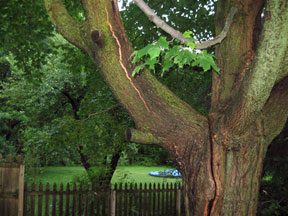Questions about storm damaged trees
Editor’s note: This article is from the archives of the MSU Crop Advisory Team
Alerts. Check the label of any pesticide referenced to ensure your use is
included.
I’ve
received a number of calls this week regarding trees that were damaged
by last weekend’s round of storms. Since these questions are typical
after our spring storms, I’ll share them with Landscape Alert readers.
My tree blew over with the roots still intact. Can I stand the tree back up?
The answer depends on the nature of the tree. If this is a tree that was
recently planted this spring or last year and the root ball is intact,
then you should be able to stand the tree back up. The tree will need to
be staked for the remainder of this year and probably next year, but
that should give it enough time to expand its root system and become
wind-firm. If the tree is a large, established tree then trying to stand
it back up would have dubious merit. It is possible for large trees to
survive wind-throw after being righted and braced. But the question then
becomes, what’s to keep the tree from falling again? The tree will
likely have to be cabled or braced permanently to keep it upright and in
most situations this is not an option.
I have a large limb on my tree that was damaged, do I need to remove it?
The key factors to consider here are: How extensive is the damage to the
branch? And if the branch failed, what would it hit? For example, a
homeowner sent me a photo of a branch that cracked during the weekend
storms (see photo). In this case, the branch has three strikes against
it: 1) the recent crack looks to be fairly extensive and may result in
extensive die-back on the limb, 2) the branch has poor attachment to the
main trunk due to an earlier crack and 3) the limb is overhanging the
house (just to the left of the photo). For further insights on assessing
tree damage, visit the National Arbor Day Foundation guide to assessing
trees after storm damage: http://www.arborday.org/media/stormrecovery/2_canthesetreesbesaved.cfm
It is important to note that assessing and dealing with potentially hazardous trees is a deadly serious business. If you have damaged trees, be sure to flag off the area to prevent people from walking underneath threatening limbs and be sure to have the trees assessed by a reputable tree service company.
We have had people come to our door and offer to clean up our storm damage, should we let them?
As with many things, it depends. If the neighbor kids want to pick up
leaves and downed branches, that’s probably okay. If you’re dealing with
any kind of overhead tree work or any work near utilities, then you
should contact a professional tree service. Look for companies that are
insured and preferably ISA (International Society of Arboriculture)
certified. In some areas “door knockers” will make the rounds offering
to clean up trees. Door knockers range from hardworking folks trying to
make an honest buck to out-right scam artists. In either case, improper
tree work can do as much damage to your trees as the storm itself. You
also need to consider what happens if fly-by-night tree service drops a
tree on your house or your neighbor’s car. As with most things in life,
you get what you pay for. A professional service has to cover the costs
of insurance, proper training, high quality equipment, and paying good
quality employees. To find an ISA certified arborist in your area, visit
the ISA website:
http://www.isa-arbor.com/findarborist/findarborist.aspx



 Print
Print Email
Email





